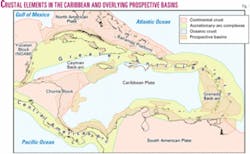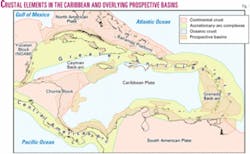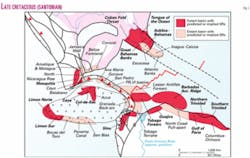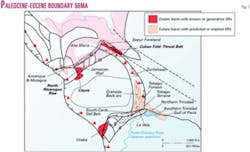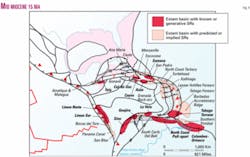Caribbean source rocks may point toward buried treasure
Despite its significance as a source of oil and gas on the doorstep of the US market, the Caribbean offshore region is poorly explored, especially in the deep water.
Exploration Consultants Ltd. (ECL) and Inseis-Terra have completed an appraisal of the Caribbean that recognizes 63 offshore basins situated on eight different types of crust or hybrid crust (Fig. 1).
Till now, source rocks have not been systematically appraised for the Caribbean partly due to the paucity of exploration but also due to the complexity of its geodynamic evolution. The key to understanding regional source rock potential lies in placing the source rocks in a proper geotectonic context at the time of deposition.
Genetic controls on source rock development
Many reviews of source rocks simply identify the stratigraphic epochs (or formations) in which source rocks occur, without any further analysis. We evaluate the controlling (or genetic) factors for their occurrence and distribution, particularly recognizing the importance of major geodynamic (tectonic) processes.
Geotectonic setting
The ECL/Inseis-Terra work includes a comprehensive review of the geodynamic evolution of the Caribbean.
We subscribe to the mobilist view (e.g., Pindell and Barrett)1 that the Caribbean plate is of Pacific origin and has moved eastwards relative to the North and South American plates (NOAM and SOAM) from the Aptian or Albian.
Before the Caribbean began its eastward movement an early island arc developed (Late Jurassic to Early Cretaceous) termed the Greater Antilles Arc (GAA), which then progressed at the margins of the Caribbean plate through the rest of the Cretaceous and Tertiary.
In the Turonian to Santonian a giant volcanic plateau formed (possibly hot-spot related) over large areas of the Caribbean plate which thickened the crust and created the Caribbean Oceanic Plateau (COP). Immediately following this the GAA started to collide obliquely at both its northern and southern margins, thus beginning the Sepur orogeny in the north, which continued until the Oligocene, while in the south the Antillean Orogeny persisted throughout the Tertiary.
A second island arc was initiated in the Paleogene on the western edge of the COP. This formed the Central Americas (CA) arc, attached to the NOAM crustal fragments in the north and eventually colliding with SOAM in the Pliocene.
The Caribbean sector has five major crustal elements, the NOAM, SOAM, GAA, COP, and CA forming the basement to all of the basins identified (Fig. 1). Each of the crustal elements has a peculiar set of basin development criteria and consequently different tectono-stratigraphies and mechanisms of source rock development. An obvious example of this is that Late Triassic to Jurassic synrift source rock intervals can only be present on NOAM or SOAM crust.
Key ages of source rock deposition
Analysis of age distribution of source rocks is a reflection of the geodynamic and paleogeographic factors that control their formation.
Qualitative analysis of the number of times a source rock interval occurs in the 63 basins highlights five main time intervals that account for 90% of the source rock potential.
Two time intervals are the most important: the Cenomanian to Santonian, and the Miocene to Pliocene. These account for over 60% of the entire regional source rock potential. They are followed by source rocks in the Late Triassic to Jurassic and the Paleocene to Early Eocene time intervals, which have about 10% each, and finally the Oligocene with about 5%.
The distribution of source rocks can be related to the basement type (a reflection of the geotectonic setting), and specific geodynamic events occurring during that time interval. They are presented below in time-order and are illustrated with plate tectonic reconstructions (based largely on the Pindell model) which show a palinspastic restoration of basins containing source rocks during that time interval.
Late Triassic to Jurassic
This period encompasses the initial spreading of the Atlantic and Proto-Caribbean which was accompanied by the formation of a spectrum of early- to late-rift and early-drift phase source rocks.
These are marine restricted basin and hypersaline deposits, often associated with evaporites, as seen in the Smackover formation in the Gulf of Mexico. These have high levels of terrestrial input, with limited marine-derived organic matter. The hosting basement types are NOAM and SOAM only, as the other crustal types are formed later.
Cenomanian to Santonian
This is one of the two most important time intervals of source rock development in the Caribbean, occurring on all basement types (Fig. 2).
Geotectonic settings are variable, but with NOAM and SOAM deposition was typically on passive margins, as exemplified in Venezuela by the Turonian La Luna formation.2 Intraarc basins on the GAA and the very early CA, and the COP also have good potential for source rocks in this time interval.
The most commonly invoked mechanism for the development of organic-rich sediments during this time interval (e.g., Luning et al.)3 relates to global sea-level highstands that flooded passive margins of Tethys, the Atlantic, and in the Caribbean region.
Oceanic stratification of dissolved oxygen is an observed phenomenon, and the implication of this hypothesis is that sea-level rise was of such a large magnitude that the disaerobic water layer normally residing near the base of the continental slopes was raised up onto passive margin platforms (and the marine platforms of Oceanic Plateau), creating better conditions for the preservation of organic matter resulting from enhanced organic productivity.
The worldwide Cenomanian-Turonian organic rich interval has been designated the Oceanic Anoxic Event 2 (OAE2). In the Caribbean, OAE2 is generally invoked in the classic areas of the Venezuelan- Trinidadian passive margin (SOAM).2
Elaborations of this hypothesis have suggested that the generally-higher productivity in the oceans at this time, linked with better preservation potential and the shelf-to-deep basin transport of organic material, can result in source rocks preserved in sediments at abyssal water depths. We have demonstrated the deposition of 'La Luna' type source rocks on Atlantic oceanic crust at this time, which was later subducted' leading to oil generation in the Barbados accretionary prism.
Kerr4 suggested that a more local cause of Turonian to Santonian source rocks could be the effects of the massive eruption accompanying the formation of the Caribbean Oceanic Plateau (COP). In Kerr's model this starts a positive feedback mechanism that results in increased organic carbon burial at the same time as reduced carbonate precipitation from the oceans, leading to widespread deposition of black shales.
This explains source rock development on the COP observed in outcropping representatives of the COP in Panama, Costa Rica, Colombia and Hispaniola. They have also been observed in situ in Turonian strata in DSDP boreholes.5
In summary, it is likely that several mechanisms for source rock deposition have operated in the Cenomanian to Santonian time interval, and this combination of events has led to exceptional source rock formation and preservation over large parts of the Caribbean region including the deep water.
Paleocene to Early Eocene
Source rocks of this time interval have only formed on NOAM, SOAM, and GAA crust, and are not found on the COP and CA (Fig. 3). This time interval has the third greatest potential.
Most of the basins that have source rocks in this time interval are orogenic, usually at foredeep stage at this time (e.g., the Cuban fold-thrust belt or the Gulf of Paria). Other tectonic settings include transtensional basins associated with the formation of the Cayman oceanic plate (Early Eocene) in the northwestern Caribbean.
Oligocene
Source rocks of Oligocene age are known or predicted in three distinct geotectonic settings around the Caribbean. They are best known off the north coast of Venezuela where oil-prone source rocks are identified in post-orogenic transtensional basins.
Other occurrences on the Nicaragua Rise and around Puerto Rico are linked to subsidence driven by post-tectonic relaxation, and the formation of carbonate platforms.
Early, Mid, and Late Miocene and Pliocene
This is one of the two most important source rock intervals in the Carib- bean, mainly located in GAA and SOAM basins, with lesser development in basins on all other types of crust (Fig. 4).
There are three distinct geotectonic settings for the source rocks in this time period, one linked to late- or post-orogenic transpressional basins, especially in CA and northern GAA. Another is related to transtensional basin formation on the GAA (particularly the Tobago Terrane) and along the northern margin of South America.
The third setting is the preorogenic (or very early syn-) Columbus-Orinoco basin off eastern Venezuela, which has source-rock types similar to those in the transtensional basins.
Source rocks in the transtensional basins (and the Columbus-Orinoco basin) are dominantly gas-prone, and biogenic gas production is the most important mechanism, typified by the Guajira basin (Colombia). These mainly (but not exclusively) occur in the later stages of this time interval. Conversely, transpressional basins seem to have higher proportions of marine, oil-prone organic material, typified by the Azua basin (Dominican Republic).
Exploration implications
Multiple source rock levels have developed in the Caribbean including the deepwater areas. Their distribution in space and time can be rationalized in terms of the geotectonic setting at time of deposition.
Caribbean source rocks are dominated by two major groups: marine sediments deposited in the Cenomanian to Santonian interval, traditionally attributed to OAE2, but with several local influences that may include the contemporaneous formation of the COP; and Miocene to Pliocene biogenic gas-prone rocks, where maturation is strongly controlled by Neogene and Quaternary tectonics, in either pull-apart (transtensional) or compressional settings.
Otherwise, source rocks are locally developed, frequently in specific tectonic settings, such as collisional foredeeps (Paleocene, Early Eocene and Oligocene) and rift grabens (Late Triassic to Jurassic).
Source rocks appear to be particularly well-developed in the basins formed along the collisional zones of the GAA with the North and South American plates. Some of this could be a reflection of the intensity of exploration in those areas.
Once the degree of exploration in a given basin is factored in, target areas with good source rock potential and very little prior exploration can be identified. This highlights unusual and relatively obscure basins, such Limon Norte in Costa Rica; the Dutch Antilles sector of the La Vela basin; and others in the Bahamas, Haiti, Colombia, Honduras, and Jamaica. F
References
1. Pindell, J., and Barrett, S., "Geological evolution of the Caribbean region," in Dengo and Case, eds., "The Caribbean Region, The Geology of North America," Vol. H, GSA, Boulder, Colo., 1990, pp. 405-432.
2. James, K.H., "The Venezuelan hydrocarbon habitat, Part 1: Tectonics, Structure, Palaeogeography and Source Rocks," Journal of Petroleum Geology, Vol. 23, 2000, pp. 5-53.
3. Luning, S., Kolonic, S., Belhadj, E.M., Belhadj, Z., Cota, J., Baric, G., and Wagner, T., "Integrated depositional model for the Cenomanian-Turonian organic rich strata in North Africa," Earth Science Reviews, 2003, in press.
4. Kerr, A., "Oceanic plateau formation: A cause of mass extinction and black shale deposition around the Cenomanian-Turonian boundary," Journal of the Geological Society London, Vol. 155, 1988, pp. 619-626.
5. Pierce, S., "Oil signs alluring, but commercial find still elusive in Dominican Republic," OGJ, Mar. 25, 2002, p. 40.
Bibliography
Tissot, B., Delteil, J.R., Demaison, G., Combaz, A. and Masson, P., "Paleoenvironment and petroleum potential of Middle Cretaceous black shales in Atlantic basins," AAPG Bull., Vol. 64, 1980, pp. 2,051-63.
The authors
Kevin Leahy is senior geologist at Exploration Consultants Ltd. specializing in regional and basin geodynamics. He joined ECL in 1998 after a spell at RDR Leeds. He has a BSc Hons. degree and PhD from Leeds University.
Steve Lawrence (steve.lawrence @ecqc.com) is chief geologist at ECL supervising exploration projects in Africa, the Caribbean, and the Middle East. Before joining ECL in 1978 he was an operations and exploration geologist for Amoco UK and Cluff Oil Ltd. He has a BSc Hons. degree in geology from London University.
John Thrift has over 30 years experience in seismic data acquisition and processing both as contractor and consultant. Employed at Terra Energy Services, he is responsible for developing the company's nonexclusive seismic data library off West Africa and Central and South America. He graduated with a geology degree from Nottingham University.
